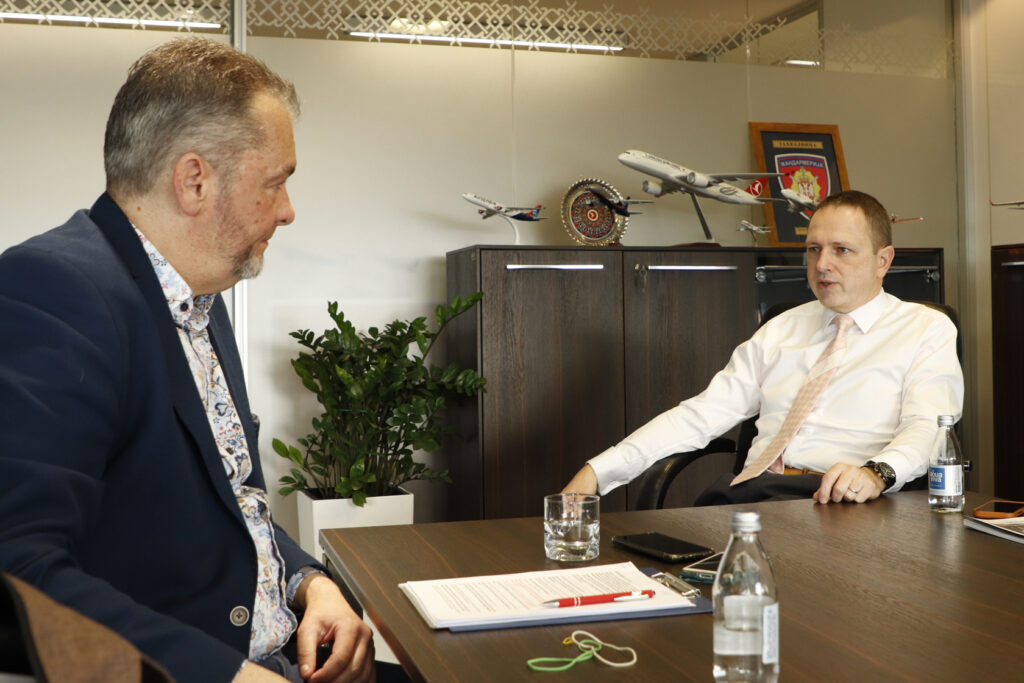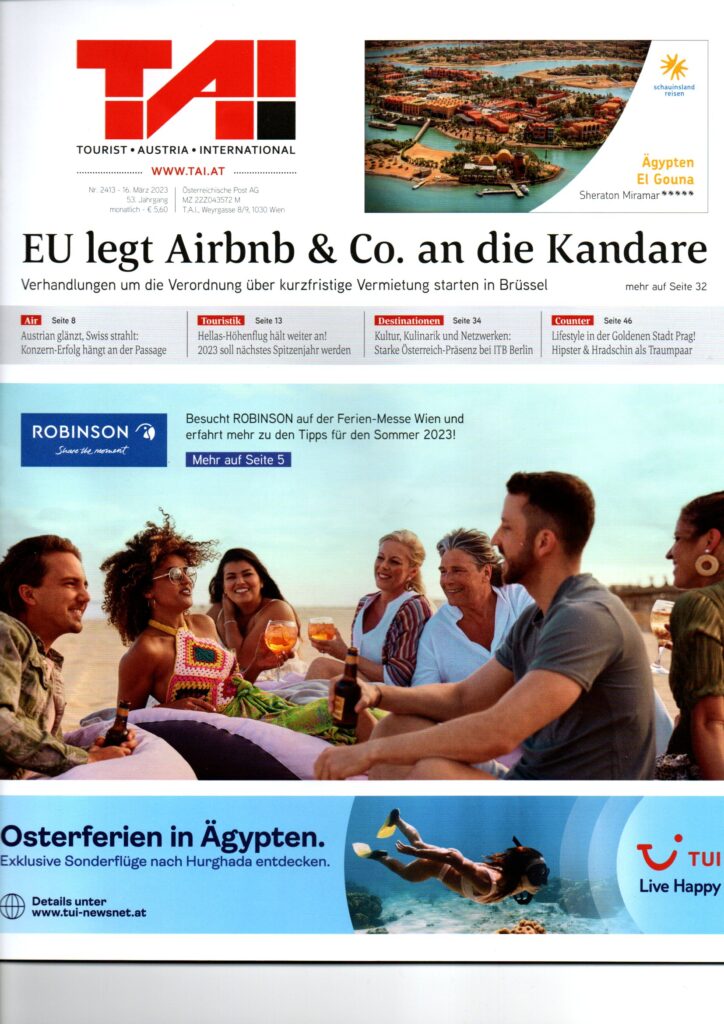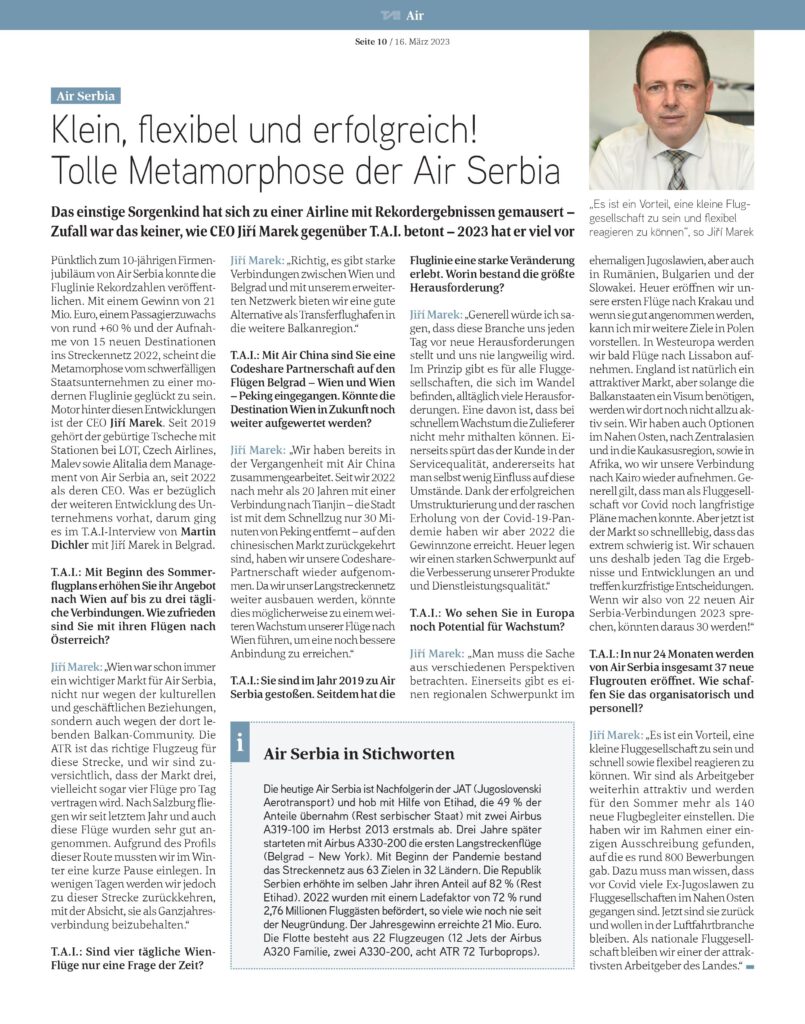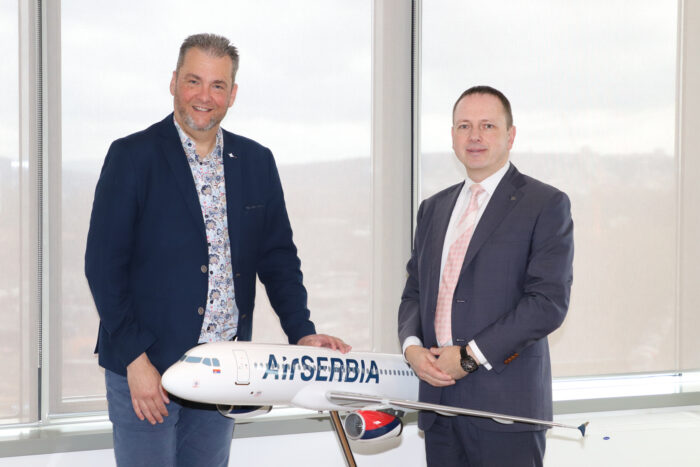Just in time for Air Serbia’s 10th anniversary, the state-owned airline recently published new record figures. With a profit of 21 million euros, a passenger increase of around +60% and the addition of 15 new destinations to the route network, the metamorphosis from a cumbersome state-owned company to a modern airline seems to have succeeded.
The driving force behind these developments is the new CEO Jiri Marek. Since 2019, the Czech has been breathing a lot of fresh air into the company. T.A.I Magazine spoke with him in Belgrade about the further development of his company.
T.A.I:
Let’s start right away with a topical question about the Austrian market.
With the start of the summer flight schedule, you are increasing your service to Vienna to up to three daily connections. How satisfied are you with your flights to Vienna and Salzburg?
Jiri Marek:
Vienna has historically always been an important market for Air Serbia, due to cultural and business ties, as well as because of a number of Balkan communities living there. We have always wanted to expand our services to Vienna and have been waiting for the right moment to do so. The moment came last year when we completed the renewal of our ATR 72-600 turboprop fleet. The ATR is the right aircraft for this route and we are confident that the market will bear three, perhaps even four, flights a day.
Regarding Salzburg, we started flights last year and they were very well received. We had to make a short break during the winter due to the profile of this route, which is very dependent on weather conditions at the arrival airport. However, in a few days we will be returning to this route with the intention of keeping it as a year-round service.

That means four daily flights to Vienna are only a matter of time?
That’s right, there are strong ties between Vienna and Belgrade and with our expanded network we are offering a well-positioned alternative as a transfer airport to the wider Balkan region.
You have just entered into a codeshare partnership with Air China on the Belgrade-Vienna and Vienna-Beijing routes. So, destination Vienna could be upgraded even further in the future?
We have cooperated with Air China in the past and since last year, after more than 20 years, we returned to the Chinese market when we started our service to Tianjin, a city only 30 minutes distant from Beijing by fast train, we have re-established and further expanded our codeshare partnership with Air China in order to offer our customers greater variety in travel options. As we will continue to develop our long-haul network, that might possibly unlock further growth of our flights to Vienna for even better connectivity.
Your attempt to establish flights from Austria to Kraljevo and Nis did not go so well in the past?
These flights were so-called PSO (Public Service Obligations) flights, which were operated on behalf of the Serbian government and Air Serbia obtained the right to operate these routes on the basis of a tender. These flights were actually only operated for a very short time in 2019, and were completely discontinued with the outbreak of the Covid pandemic. A new tender followed for these PSO flights, in which we participated again, but the choice fell on other destinations such as Istanbul or Thessaloniki.
What is the importance of the German-speaking (D-A-CH) market in general for Air Serbia?
As Balkan communities are widely represented in the DACH region, any such market is strategically important for Air Serbia. Additionally, Belgrade is a natural geographical gateway for the flow from those markets southward, to countries like Greece and Italy. Another aspect is strong investment from German companies in Serbia and the ever-growing connectivity of Air Serbia offers easy access for this type of market segment for Serbia and the region.
You joined Air Serbia in 2019 and became CEO in January 2020. Since then, your airline has undergone a lot of changes, what has been the biggest challenge for you?
I would say, in general, this industry gives us new challenges every day and we never get bored. In principle, there are a lot of challenges for all airlines that are in the process of transformation. One of them is certainly when you grow so fast that your suppliers can’t keep up with you. On the one hand, the customer feels this shortcoming in the quality of service, but on the other hand, you yourself have little leverage on these circumstances. Thanks to the successful transformation and fast recovery from the Covid-19 pandemic, we achieved profitability in 2022 and this year we will put strong emphasis on elevating our product quality and service consistency.
Last year you added 15 new destinations, and for 2023 you have announced the opening of 22 more destinations. How long do you plan to continue growing at this pace?
The studies of international organizations such as IATA and forecasts done by OEMs show that our market will not only recover quickly, but will continue to grow at a faster pace than the rest of Europe. In this region the propensity for travel per capita is lower than the European average. Hence, it is natural to assume that with growing disposable income the demand for travel and number of trips per citizen will keep growing above the organic forecast.
Where do you still see potential for growth in Europe?
You have to look at it from different perspectives. On the one hand, there is a regional focus, where there is still definite potential in the former Yugoslavia, but there are also growth opportunities in Romania, Bulgaria and Slovakia. This year, for example, we are opening our first flights to Krakow, and if these flights are well received, I can imagine more destinations in Poland. In Western Europe, we will soon be launching one of our longest flights, Lisbon. England is of course an attractive market, however as long as Balkan communities require a visa, we will not be too active there yet. We also have options in the Middle East, to Central Asia and the Caucasus region, as well as in Africa, where we are reopening our connection to Cairo.
Before Covid, you could still make long-term plans as an airline, but now the market is so fast-moving that this is extremely difficult. Now we look at the results and developments every day and make short-term decisions. So, if we are talking about 22 new Air Serbia connections in 2023, that may turn into 30!
Starting May you are opening a connection to Chicago, how satisfied are you with the development of the long-haul route to New York and Tianjin and how important is this for the future of Air Serbia?
For a long time, Air Serbia only had its connection to New York. Being a small airline, it is always a big decision to expand our long-haul offer and to acquire another wide-body aircraft. Last year, we decided to take this step when we saw development opportunities in China. We opened our connection to Tianjin in December, the flights have been profitable since the beginning, which is why we are currently working on the approvals not only for the expansion of this connection, but also for flights to Beijing and Shanghai. At the same time, it was also logical for us to expand with our second A330-200 to North America, specifically to Chicago, where there is a large Serbian and Balkan community.
We are now working on the acquisition of a third A330, which could join our fleet in July. In the long term, five long-haul aircraft would be the target, but as we are seeing at the moment, the long-haul routes are developing relatively well, so perhaps more units could be considered.
How much does the cargo business contribute to the success on long-haul routes?
Air cargo is particularly important to us, for example we carry up to 17 tonnes of air cargo on almost every flight from China. If we get the opportunity, we would also like to integrate a freighter into our fleet, but at the moment the market for converting these aircraft is booked out for at least two years.
Are we talking only about an A330 or could this also be another aircraft of this size?
In principle I am talking about an Airbus A330, but for a freighter it could also be other aircraft of this size. However, we would like to keep the fleet commonality and therefore A330 would be preferred.
And the demand for air cargo is so great that it would pay off for Air Serbia to operate its own cargo aircraft?
Serbia is quickly developing its infrastructure paying particular attention to intermodal solutions and we strongly believe that Belgrade could develop as an alternative cargo hub and become a regional centre of gravity for this segment of the business, alternative to, for example, Budapest.
What new long-haul routes could be of interest to Air Serbia in the future?
We would like to expand in a balanced way between East and West on long-haul routes. As we are already in North America, we see a very high potential in China. Studies show that demand from China will far outstrip that from North America, so Beijing and Shanghai are definitely planned priorities. Tianjin could remain a niche destination in the network, depending on how Beijing and Shanghai flights will impact it. In North America, New York and Chicago have been a logical choice, but Toronto and Miami could also be considered next, although the above destinations all have their pros and cons. We are currently still evaluating them and both destinations have an equal chance.
In order to be able to serve your flight offer, you already resorted to leasing aircraft from other airlines last year. How many aircraft will be leased this year and which airlines are you working with?
We already have a very good partnership with Dan Air and Air Connect. Air Connect is still a very young company that started operations last year and specialises in ATR 72-600 aircraft. We will continue to lease external aircraft as a reasonable way to respond to growing demand and bridge the period towards introducing aircraft into our fleet. At the moment, we plan to have five-six aircraft on wet lease, one to two ATRs from Air Connect and four Airbus jets from Dan Air.
Let me briefly summarise, in just 24 months, a total of 37 new routes will be opened and your hunger for expansion seems to continue unabated! Many a large airline would have problems here, how do you manage both organisationally and in terms of personnel?
It is an advantage to be a small airline and to be able to react quickly and flexibly. As far as staff is concerned, we continue to have a very attractive proposition as an employer. We will be engaging more than 140 new flight attendants for the summer, and we found them within a single call for applications, where around 800 applicants applied. You have to know that before Covid, a lot of ex-Yugoslavs went to many well-known airlines in the Middle East. Now they are back in their homeland and want to stay in the aviation sector. As a national airline with a success story, we remain one of the most attractive employers in the country.
You flew in a profit of 21 million euros last year, what was the key to your success?
A combination of several things! We used Covid to completely reorganise ourselves, cut costs and become efficient. We carried about the same number of passengers last year as we did in 2019, with 35% less staff in non-operational areas. This is an impressive demonstration of the efficiencies we have brought to the business during Covid. We have also responded very quickly to demand for new destinations in the market, especially in leisure travel. The combination of lower cost and higher revenue naturally means being profitable.
Martin Dichler


